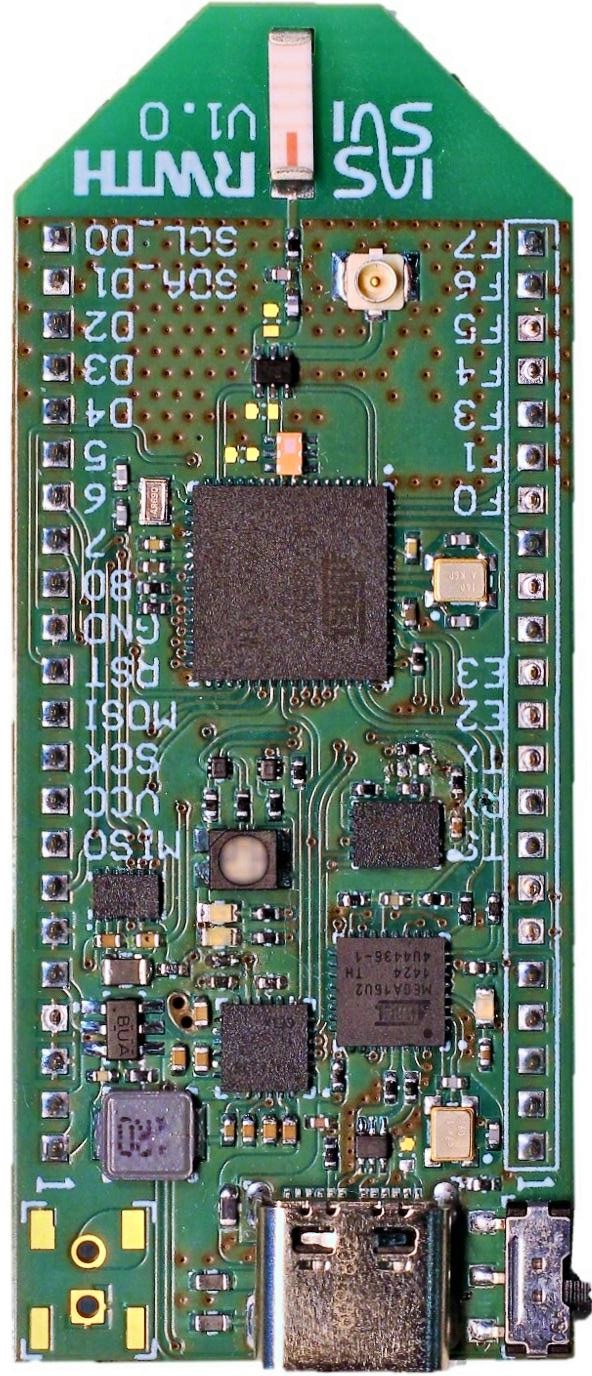2018-08-10 10:59:39 +02:00
/**
* @defgroup boards_jiminy-mega256rfr2 Jiminy- Mega256rfr2
* @ingroup boards
* @brief Support for the Jiminy Mega 256rfr2 board
2018-10-19 15:13:32 +02:00
# Overview
The Jiminy board is a development of the
[Chair of Integrated Analog Circuits and RF Systems](http://www.ias.rwth-aachen.de/cms/~gair/IAS/?lidx=1)
(IAS) of the [RWTH Aachen University](https://www.rwth-aachen.de/). We started the project by porting
RIOT OS to the [Pinoccio.io](https://github.com/Pinoccio/hardware-pinoccio) board. As there where severe
limitations we designed the Jiminy board which has the the
[ATmega256rfr2](www.atmel.com/Images/Atmel-8393-MCU_Wireless-ATmega256RFR2-ATmega128RFR2-ATmega64RFR2_Datasheet.pdf)
MCU as common feature.
It is Arduino like and features USB programming. The [Bootloader](https://github.com/Josar/arduino_stk500v2)
is a fork of the Arduino Bootloader with added functionality for internal clock calibration and automatic baud
rate detection.
The Jiminy is design as a core board featuring a MCU, RF-transceiver, battery charger and power path management
IC, a fuel gauge, an adjustable power supply between 1.8V to 3.3V (100mV Steps) and an RGB LED. All unused Pins
are connected to pin headers.
An USB C connector is used to connect to the computer or the charger. As USB C supports up to 3 ampere the board
was designed in regard of fast charging and when connected to the grid or usage of big batteries high current
supply capability for the shield.
The shields can be powered either directly from the Charger/battery or from the adjustable converter, the
converter supply pin can be enabled or disabled by the application. By connecting shields to the core Jiminy
board, a multitude of wireless applications can be created.
A first shield for temperature, humidity and soil moisture measurement is also developed at the IAS.
If there is demand for devices please contact the author of this page for more details.


# Hardware
## Pinout

## Board
The jiminy board has following ICs and features.
| Features | Details | Datasheet |
|:------------- |:--------------------- |:------------- |
| USB2Serial| ATmega16U2, High-performance, low-power AVR 8-Bit Advanced RISC Architecture | [Link](http://www.microchip.com/wwwproducts/en/ATmega16u2) |
| MCU | ATmega256, AVR 8-Bit Advanced RISC Architecture |[Link](www.atmel.com/Images/Atmel-8393-MCU_Wireless-ATmega256RFR2-ATmega128RFR2-ATmega64RFR2_Datasheet.pdf) |
| Transceiver | High performance RF-CMOS 2.4 GHz radio transceiver targeted for IEEE802.15.4, ZigBee, IPv6 / 6LoWPAN, RF4CE, SP100, WirelessHART and ISM applications | above |
| Li-ion Charger and Power Path | bq24298 , 3A Single Cell USB Charger With Power Path Management|[Link](www.ti.com/lit/ds/symlink/bq24298.pdf) |
| Fuel Gauge| LC709203F, Fuel Gauge for a single lithium ion battery which provides accurate RSOC information even under unstable conditions (e.g. changes of battery temperature, loading, aging and self-discharge) |[Link](www.onsemi.com/pub/Collateral/LC709203F-D.PDF) |
| AC Converter | TPS6274x, Output voltage selectable within a range from 1.8V to 3.3V in 100mV steps, output currents up to 300mA | [Link](www.ti.com/lit/ds/symlink/tps62740.pdf) |
| RGB LED | Cree LED, hardware PWM controlled |[Link](www.cree.com/led-components/media/documents/CLVBAFKA.pdf) |
## MCU Details
| MCU | ATmega256RFR2 |
|:------------- |:--------------------- |
| Family | ATmega |
| Vendor | Atmel |
| Package | QFN/MLF |
| SRAM | 32Kb |
| Flash | 256Kb |
| EEPROM | 8K |
| Core Frequency | 8MHz (16MHz no power save mode) |
| Oscillators | 32.768 kHz & 16 MHz |
| Timers | 6 ( 2x8bit & 4x16bit ) |
|Analog Comparator | 1 |
| ADCs | 1x 15 channel 6 to 12-bit |
| USARTs | 2 |
| SPIs | 3 (1 SPI & 2 USART SPI) |
| I2Cs | 1 (called TWI) |
| Vcc | 1.8V - 3.6V |
| Datasheet / Reference Manual | [Datasheet and Reference Manual](www.atmel.com/Images/Atmel-8393-MCU_Wireless-ATmega256RFR2-ATmega128RFR2-ATmega64RFR2_Datasheet.pdf) |
| Board Manual | |
| Pins | |
# Implementation Status
Is an ongoing process ...
## Jimini Core
| Driver | Status | Comment |
|:------------- |:--------------------- |:--------------------- |
| GPIO (LED) | OK | |
| Timers | OK | |
| UART | OK | |
| TWI, I2C | OK | |
| PWM | OK | only PWM_left implemented yet |
| Comparator | OK | |
| Module | Status | Comment |
|:------------- |:--------------------- |:--------------------- |
| Stdio| OK | Output to USB Bridge, used as Terminal |
| xTimer | OK | |
| PWM LED | OK | |
| RTC| OK | |
| Power Path | OK | |
| Fuel Gauge| OK | |
| RF core | Work in progress | |
| CoAP | Status | Comment |
|:------------- |:--------------------- |:--------------------- |
|Device| | |
|LED| | |
| Battery | ok | only RSOC so far |
## Jimini Plant Sensor Shield
| Module | Status | Comment |
|:------------- |:--------------------- |:--------------------- |
| SHT21 | OK | |
| Soil moisture | OK | |
| CoAP | Status | Comment |
|:------------- |:--------------------- |:--------------------- |
| Temperature | ok | |
| Humidity | ok | |
| Soil moisture | ok | when requested the first time the returned value is wrong, after that the correct value is returned |
# Flashing RIOT
Flashing RIOT on the Jiminy is quite straight forward, just connect your Jiminy using the USB port
to your host computer and type:
`make flash BOARD=jiminy-mega256rfr2`
This should take care of everything!
RIOT's Makefile are configured to flash the jiminy using AVRDUDE. The bootloader automatically matches
to the configured baud rate which is set for AVRDUDE. Rates of up to 500kBaud can be used.
2018-08-10 10:59:39 +02:00
*/